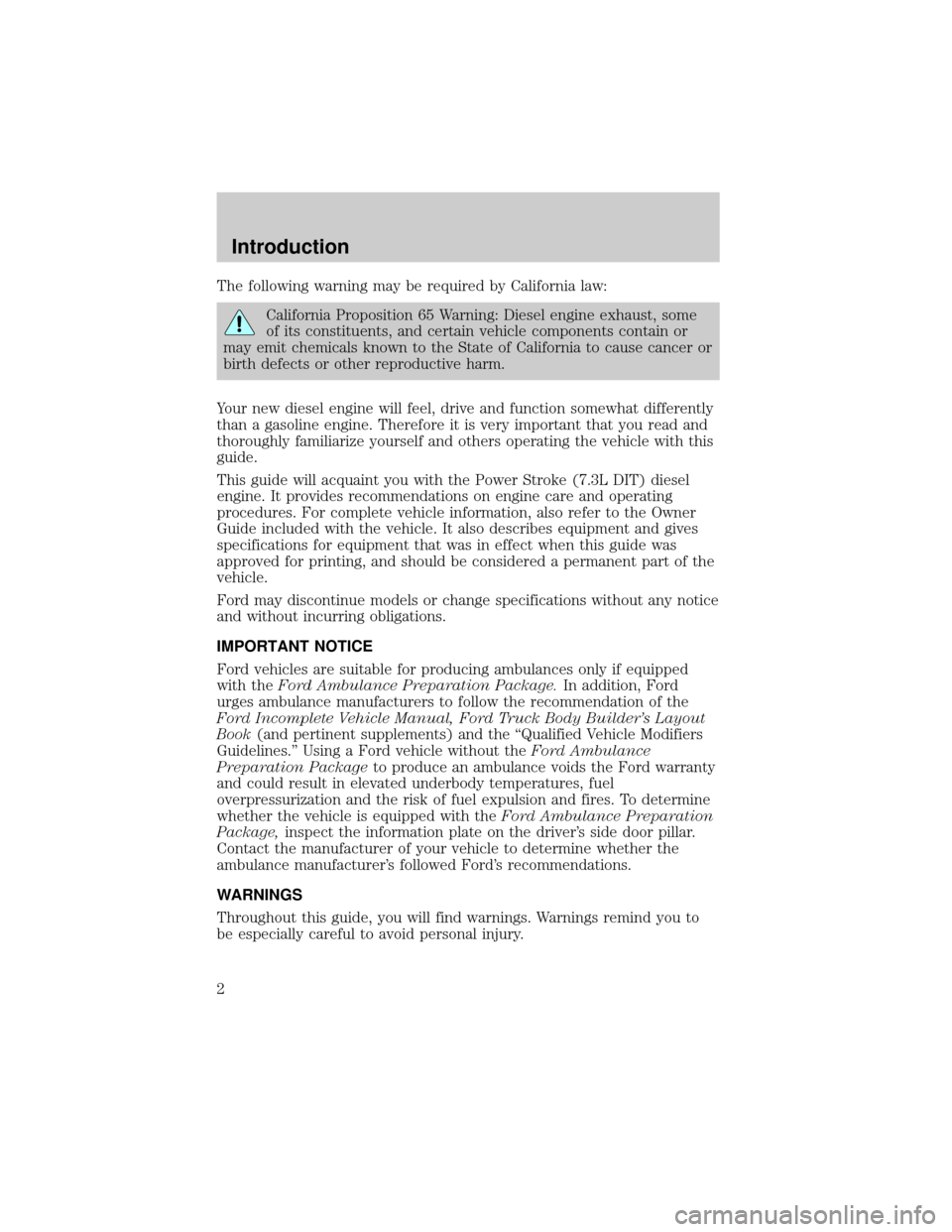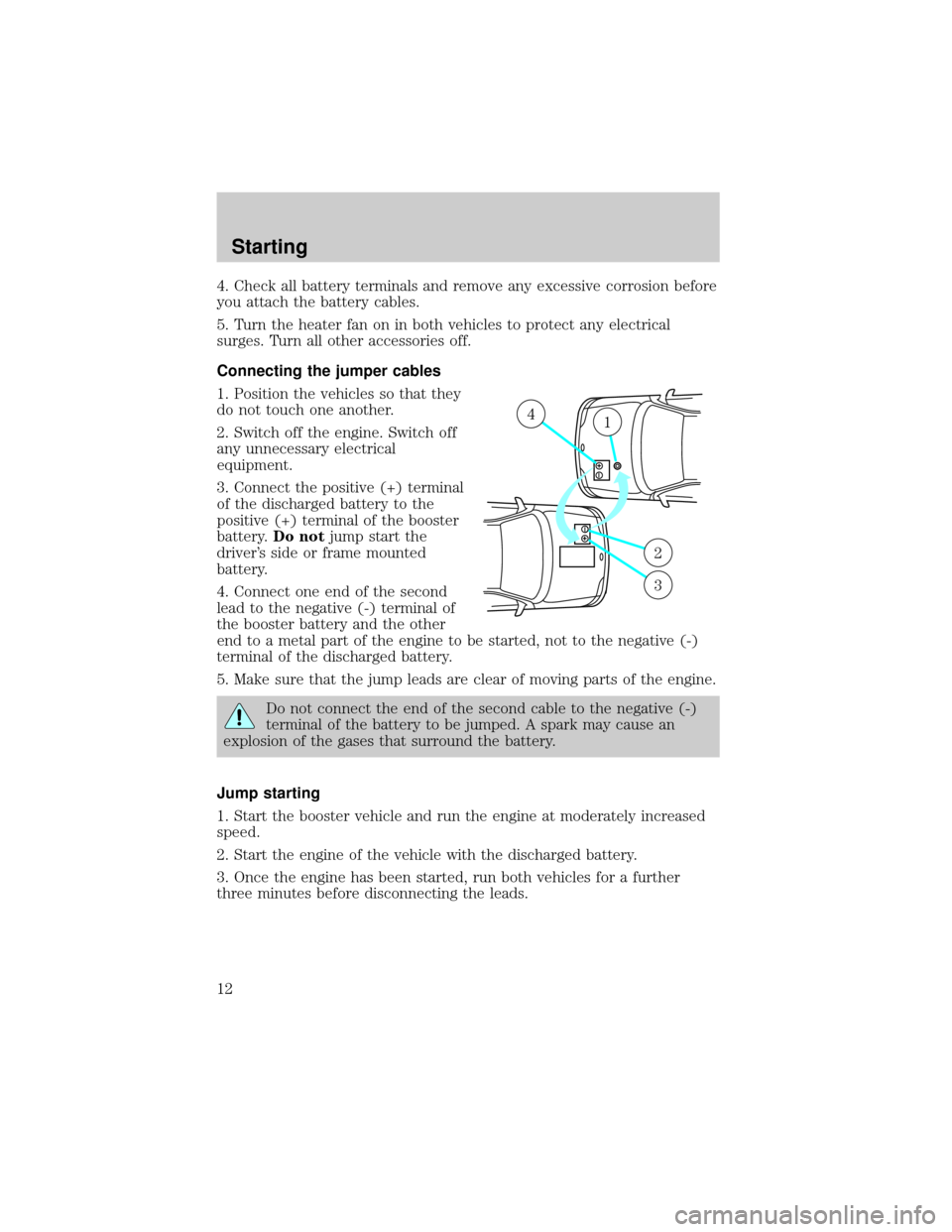Page 2 of 39

The following warning may be required by California law:
California Proposition 65 Warning: Diesel engine exhaust, some
of its constituents, and certain vehicle components contain or
may emit chemicals known to the State of California to cause cancer or
birth defects or other reproductive harm.
Your new diesel engine will feel, drive and function somewhat differently
than a gasoline engine. Therefore it is very important that you read and
thoroughly familiarize yourself and others operating the vehicle with this
guide.
This guide will acquaint you with the Power Stroke (7.3L DIT) diesel
engine. It provides recommendations on engine care and operating
procedures. For complete vehicle information, also refer to the Owner
Guide included with the vehicle. It also describes equipment and gives
specifications for equipment that was in effect when this guide was
approved for printing, and should be considered a permanent part of the
vehicle.
Ford may discontinue models or change specifications without any notice
and without incurring obligations.
IMPORTANT NOTICE
Ford vehicles are suitable for producing ambulances only if equipped
with theFord Ambulance Preparation Package.In addition, Ford
urges ambulance manufacturers to follow the recommendation of the
Ford Incomplete Vehicle Manual, Ford Truck Body Builder's Layout
Book(and pertinent supplements) and the ªQualified Vehicle Modifiers
Guidelines.º Using a Ford vehicle without theFord Ambulance
Preparation Packageto produce an ambulance voids the Ford warranty
and could result in elevated underbody temperatures, fuel
overpressurization and the risk of fuel expulsion and fires. To determine
whether the vehicle is equipped with theFord Ambulance Preparation
Package,inspect the information plate on the driver's side door pillar.
Contact the manufacturer of your vehicle to determine whether the
ambulance manufacturer's followed Ford's recommendations.
WARNINGS
Throughout this guide, you will find warnings. Warnings remind you to
be especially careful to avoid personal injury.
Introduction
2
Page 12 of 39

4. Check all battery terminals and remove any excessive corrosion before
you attach the battery cables.
5. Turn the heater fan on in both vehicles to protect any electrical
surges. Turn all other accessories off.
Connecting the jumper cables
1. Position the vehicles so that they
do not touch one another.
2. Switch off the engine. Switch off
any unnecessary electrical
equipment.
3. Connect the positive (+) terminal
of the discharged battery to the
positive (+) terminal of the booster
battery.Do notjump start the
driver's side or frame mounted
battery.
4. Connect one end of the second
lead to the negative (-) terminal of
the booster battery and the other
end to a metal part of the engine to be started, not to the negative (-)
terminal of the discharged battery.
5. Make sure that the jump leads are clear of moving parts of the engine.
Do not connect the end of the second cable to the negative (-)
terminal of the battery to be jumped. A spark may cause an
explosion of the gases that surround the battery.
Jump starting
1. Start the booster vehicle and run the engine at moderately increased
speed.
2. Start the engine of the vehicle with the discharged battery.
3. Once the engine has been started, run both vehicles for a further
three minutes before disconnecting the leads.
+–
+–
41
2
3
Starting
12
Page 16 of 39

Your vehicle's load capacity is designated by weight, not by volume, so
you cannot necessarily use all available space when loading a vehicle.
Distribute the load so that only 10 to 15% of the total is on the tongue.
Tie down the load so that it does not shift and change the weight on the
hitch.
Towing a trailer places an additional load on your vehicle's engine,
transmission, axle, brakes, tires and suspension. Inspect these
components carefully after any towing operation.
Do not exceed the GVWR or the GAWR specified on the
certification label.
Towing trailers beyond the maximum recommended gross trailer
weight could result in engine damage, transmission/axle damage,
structural damage, loss of control, and personal injury.
F-Series trailer towing tables
GCWR (Gross Combined Weight Rating)/Trailer Weights
ModelRear axle
ratioMaximum
GCWR-kg (lbs.)Maximum trailer
weight-
kg (lbs.)
1
F-250 3.73 9 072 (20 000) 4 536 (10 000)
F-350 3.73 9 072 (20 000) 4 536 (10 000)
F-350 (DRW) 4.10 9 072 (20 000) 4 536 (10 000)
F-450 4.88 11 794 (26 000) 4 536 (10 000)
F-550
(17 500 GVW)4.88 11 794 (26 000) 4 536 (10 000)
F-550
(19 000 GVW)4.88 11 794 (26 000) 4 536 (10 000)
1Conventional/Class IV trailer hitch only. Fifth wheel trailer maximum
weights can be calculated by subtracting the GVW from the GCWR.
Driving tips
16
Page 17 of 39
AUXILIARY POWERTRAIN CONTROL MODULE (APCM)
(IF EQUIPPED)
Your vehicle may be equipped with an auxiliary PCM. It has the following
features:
RPM control
This feature is used for elevating the
engine's idle speed. Rpm control can
be activated from inside the vehicle
and can be programmed to activate
automatically upon engine start-up.
Programmable speed presets range
from 1300±2500 rpm. This is the
recommended method of elevating
idle speed for PTO applications.
Charge Protect
This feature is used for maintaining
battery charge. In ªCharge
Protectionº mode, the battery
voltage is monitors and the engine
idle speed is increased so the
battery charge is maintained as
required. Charge Protection can be
activated from inside the vehicle
and programmed to activate
automatically upon engine start-up.
LCD screen
Displays current engine speed and
battery voltage.
RPM
CONTROLCHARGE
PROTECTPOWER
RPM
CONTROLCHARGE
PROTECTPOWER
RPM
CONTROLCHARGE
PROTECTPOWER
Driving tips
17
Page 27 of 39
3.On F-Series models,open filter
drain valve by turning clockwise.
Allow to drain for approximately 25
seconds or until clean fuel is
observed. Close drain valve by
turning counterclockwise until firmly
seated.
3.On Econoline models,open filter drain valve release handle. Allow
to drain for approximately 25 seconds or until clean fuel is observed.
Close drain valve by resetting handle to original position.
4.On all models,verify that the fuel drain is closed. Close the hood and
remove the container from under the vehicle.
5. Restart the engine and check WATER IN FUEL indicator light. The
light should not glow. If it continues to glow, have fuel system checked
and repaired.
DRAIN
CLOSE
General maintenance information
27